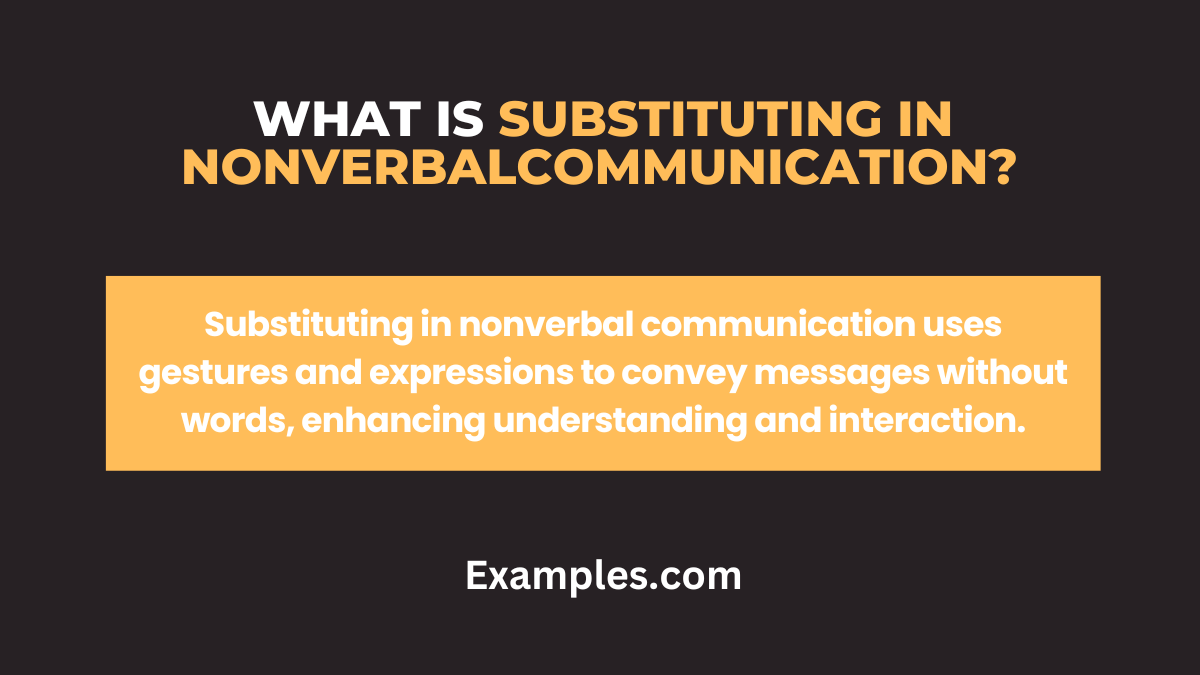10 Substituting in Nonverbal Communication Examples
Substituting in nonverbal communication involves using gestures, facial expressions, or other body language elements to replace spoken words. This aspect of communication is essential in conveying messages without verbalizing them, often leading to clearer and more impactful interactions. Understanding how to effectively substitute verbal communication with nonverbal cues can enhance expressiveness and open up new dimensions of interaction, making it a vital skill in diverse communication scenarios. This guide delves into the art and significance of nonverbal substitution.
What is Substituting in Nonverbal Communication?

Substituting in nonverbal communication refers to the practice of using nonverbal cues, such as gestures, facial expressions, or body language, to replace verbal messages. This form of communication is particularly effective in situations where words are insufficient, inappropriate, or unnecessary. For instance, a smile can substitute for a greeting, or a nod can replace a verbal agreement. Substituting with nonverbal cues is a powerful way to convey messages silently yet effectively, playing a crucial role in the dynamics of human interaction and understanding.
Types of Substituting in Nonverbal Communication

Different methods of substituting in nonverbal communication effectively replace or supplement verbal communication. The table below provides a distinctive overview:
| Type | Function | Example |
|---|---|---|
| Visual Signals | Conveying messages through visible cues. | A stop gesture with the hand instead of saying “stop.” |
| Expressive Mime | Using mime techniques to communicate ideas or emotions. | Mimicking the action of eating to indicate hunger. |
| Symbolic Gestures | Gestures that have specific, commonly understood meanings. | Nodding for affirmation instead of verbal agreement. |
| Nonverbal Sound Cues | Utilizing sounds like sighs or laughter to convey messages. | Sighing to express frustration without verbalizing. |
| Kinesthetic Communication | Communicating through movement and spatial awareness. | Stepping back to show a need for space. |
| Facial Pantomime | Using exaggerated facial expressions to convey messages. | Wide eyes to express surprise or shock. |
| Object Utilization | Employing objects to communicate messages. | Holding up a timepiece to indicate the importance of time. |
| Environmental Adaptation | Using the surrounding environment to convey messages. | Positioning a chair to signal invitation or inclusion. |
Each of these unique methods of substituting in nonverbal communication offers a way to convey messages beyond the realm of spoken words, enhancing clarity and understanding in various interaction scenarios.
What are the Ways of Substituting in Nonverbal Communication
Effective substitution in nonverbal communication can be practiced through various approaches:
- Head Gestures: Employ nodding or shaking the head as a clear nonverbal response for agreement or disagreement.
- Expressive Hand Movements: Use hand signals, like a wave or a peace sign, as substitutes for common verbal greetings or expressions.
- Emotive Facial Responses: Convey emotions like happiness, surprise, or concern through facial expressions, eliminating the need for verbal explanation.
- Body Language Cues: Leverage body postures, such as an open stance or crossed arms, to nonverbally communicate feelings or reactions.
- Intentional Eye Movement: Utilize eye behavior, like direct or averted gaze, to convey interest, avoidance, or other relational signals.
- Proxemics: Adjust your physical proximity to others to nonverbally communicate the nature of your relationship or interaction intent.
- Nonverbal Confirmations: Use gestures like nodding or a thumbs-up to provide affirmation or agreement in place of spoken words.
Incorporating these methods enhances the ability to communicate effectively without relying solely on verbal language, enriching interpersonal interactions and understanding.
What is the Importance of Substituting in Nonverbal Communication?
The importance of substituting in nonverbal communication cannot be overstated, as it plays a vital role in enhancing and sometimes even replacing verbal communication. This aspect of nonverbal communication serves several key purposes:
Enhances Understanding
- Clarity in Communication: Nonverbal cues can often convey messages more clearly and directly than words, especially in situations where verbal communication may be ambiguous or insufficient.
- Universal Appeal: Certain nonverbal cues are universally understood, transcending language barriers and aiding in cross-cultural communication.

Conveys Emotional Depth
- Expressing Emotions: Nonverbal cues like facial expressions or body language can express a range of emotions more profoundly or subtly than words can.
- Authenticity of Feelings: Nonverbal substitutions often reflect genuine emotions, providing authenticity to the communicated message.
Facilitates Silent Communication
- Useful in Silence: In situations where speaking is not possible or appropriate, such as in a quiet library or during a solemn ceremony, nonverbal cues effectively substitute verbal communication.
- Reduces Verbal Overload: They help in reducing the cognitive load of processing spoken words, making communication more efficient.
Aids in Relationship Building
- Enhancing Interpersonal Relations: Effective use of nonverbal substitution can foster stronger connections, as it often involves a more personal and intuitive form of communication.
- Building Trust and Rapport: Consistent and accurate nonverbal cues build trust and rapport, as they are perceived as more honest and unguarded.

Supports Diverse Communication Needs
- Accessibility for Diverse Audiences: Nonverbal communication is crucial for individuals who rely less on verbal communication, such as those with hearing impairments or language barriers.
- Inclusive Communication: It creates an inclusive environment by providing alternative means of expression and understanding.
How to Improve Substituting in Nonverbal Communication
Improving your ability to substitute in nonverbal communication is essential for effective and nuanced interactions. Here are some strategies to enhance this skill:
Develop Awareness of Nonverbal Cues
- Observe and Learn: Pay close attention to how others use nonverbal communication effectively. Observing body language, facial expressions, and gestures in various contexts can provide insights.
- Self-Reflection: Reflect on your own nonverbal behavior and how it aligns with your verbal communication. Consider how your gestures or expressions could be misinterpreted and work on aligning them with your intended message.
Practice Consistency
- Align Nonverbal with Verbal Messages: Ensure your nonverbal cues match the message you intend to convey verbally. Inconsistencies can lead to confusion or mistrust.
- Use Context-Appropriate Cues: Adapt your nonverbal communication to suit the context, whether it’s a formal presentation or a casual conversation.
Enhance Expressiveness
- Expressive Facial Gestures: Work on making your facial expressions more vivid and reflective of your emotions. Practice in front of a mirror to see how you appear when conveying different emotions.
- Effective Gestural Communication: Use gestures that are universally understood for greater clarity. Avoid overuse or exaggerated gestures that might distract from the message.
Improve Body Language Understanding
- Body Language Skills: Develop an understanding of body language and how different postures and movements can convey various messages.
- Feedback Reception: Ask for feedback from trusted peers or mentors about how your nonverbal communication is perceived and what could be improved.
Utilize Resources
- Educational Materials: Read books, watch videos, or attend workshops on nonverbal communication to broaden your understanding and skills.
- Professional Guidance: Consider consulting with a communication coach or therapist who can provide personalized advice and exercises to improve your nonverbal communication skills.
Engage in Active Practice
- Role-Playing: Engage in role-playing exercises to practice nonverbal communication in different scenarios.
- Mindful Communication: In your daily interactions, be mindful of using nonverbal cues effectively and observe the reactions they elicit.
Substituting in nonverbal communication transcends the boundaries of spoken language, offering a unique and impactful way to convey messages. By understanding and mastering various nonverbal cues, individuals can effectively replace or supplement verbal communication, leading to more nuanced and meaningful interactions. Whether it’s through a nod, a gesture, or a facial expression, nonverbal communication holds the power to clarify, express emotions, and foster deeper connections.
For further exploration into the world of nonverbal communication, Harvard University’s resources on nonverbal behavior provide an insightful look into the psychological aspects and the significance of body language in human interactions. Additionally, the American Psychological Association (APA) offers a wealth of information on how nonverbal cues influence interpersonal relationships and communication dynamics.



